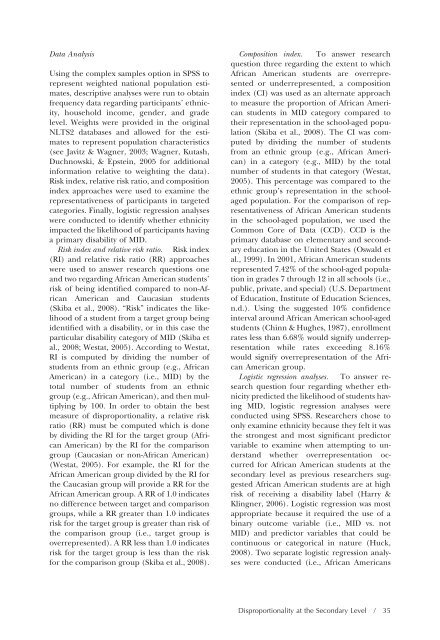etadd_48(1) - Division on Autism and Developmental Disabilities
etadd_48(1) - Division on Autism and Developmental Disabilities
etadd_48(1) - Division on Autism and Developmental Disabilities
You also want an ePaper? Increase the reach of your titles
YUMPU automatically turns print PDFs into web optimized ePapers that Google loves.
Data Analysis<br />
Using the complex samples opti<strong>on</strong> in SPSS to<br />
represent weighted nati<strong>on</strong>al populati<strong>on</strong> estimates,<br />
descriptive analyses were run to obtain<br />
frequency data regarding participants’ ethnicity,<br />
household income, gender, <strong>and</strong> grade<br />
level. Weights were provided in the original<br />
NLTS2 databases <strong>and</strong> allowed for the estimates<br />
to represent populati<strong>on</strong> characteristics<br />
(see Javitz & Wagner, 2003; Wagner, Kutash,<br />
Duchnowski, & Epstein, 2005 for additi<strong>on</strong>al<br />
informati<strong>on</strong> relative to weighting the data).<br />
Risk index, relative risk ratio, <strong>and</strong> compositi<strong>on</strong><br />
index approaches were used to examine the<br />
representativeness of participants in targeted<br />
categories. Finally, logistic regressi<strong>on</strong> analyses<br />
were c<strong>on</strong>ducted to identify whether ethnicity<br />
impacted the likelihood of participants having<br />
a primary disability of MID.<br />
Risk index <strong>and</strong> relative risk ratio. Risk index<br />
(RI) <strong>and</strong> relative risk ratio (RR) approaches<br />
were used to answer research questi<strong>on</strong>s <strong>on</strong>e<br />
<strong>and</strong> two regarding African American students’<br />
risk of being identified compared to n<strong>on</strong>-African<br />
American <strong>and</strong> Caucasian students<br />
(Skiba et al., 2008). “Risk” indicates the likelihood<br />
of a student from a target group being<br />
identified with a disability, or in this case the<br />
particular disability category of MID (Skiba et<br />
al., 2008; Westat, 2005). According to Westat,<br />
RI is computed by dividing the number of<br />
students from an ethnic group (e.g., African<br />
American) in a category (i.e., MID) by the<br />
total number of students from an ethnic<br />
group (e.g., African American), <strong>and</strong> then multiplying<br />
by 100. In order to obtain the best<br />
measure of disproporti<strong>on</strong>ality, a relative risk<br />
ratio (RR) must be computed which is d<strong>on</strong>e<br />
by dividing the RI for the target group (African<br />
American) by the RI for the comparis<strong>on</strong><br />
group (Caucasian or n<strong>on</strong>-African American)<br />
(Westat, 2005). For example, the RI for the<br />
African American group divided by the RI for<br />
the Caucasian group will provide a RR for the<br />
African American group. A RR of 1.0 indicates<br />
no difference between target <strong>and</strong> comparis<strong>on</strong><br />
groups, while a RR greater than 1.0 indicates<br />
risk for the target group is greater than risk of<br />
the comparis<strong>on</strong> group (i.e., target group is<br />
overrepresented). A RR less than 1.0 indicates<br />
risk for the target group is less than the risk<br />
for the comparis<strong>on</strong> group (Skiba et al., 2008).<br />
Compositi<strong>on</strong> index. To answer research<br />
questi<strong>on</strong> three regarding the extent to which<br />
African American students are overrepresented<br />
or underrepresented, a compositi<strong>on</strong><br />
index (CI) was used as an alternate approach<br />
to measure the proporti<strong>on</strong> of African American<br />
students in MID category compared to<br />
their representati<strong>on</strong> in the school-aged populati<strong>on</strong><br />
(Skiba et al., 2008). The CI was computed<br />
by dividing the number of students<br />
from an ethnic group (e.g., African American)<br />
in a category (e.g., MID) by the total<br />
number of students in that category (Westat,<br />
2005). This percentage was compared to the<br />
ethnic group’s representati<strong>on</strong> in the schoolaged<br />
populati<strong>on</strong>. For the comparis<strong>on</strong> of representativeness<br />
of African American students<br />
in the school-aged populati<strong>on</strong>, we used the<br />
Comm<strong>on</strong> Core of Data (CCD). CCD is the<br />
primary database <strong>on</strong> elementary <strong>and</strong> sec<strong>on</strong>dary<br />
educati<strong>on</strong> in the United States (Oswald et<br />
al., 1999). In 2001, African American students<br />
represented 7.42% of the school-aged populati<strong>on</strong><br />
in grades 7 through 12 in all schools (i.e.,<br />
public, private, <strong>and</strong> special) (U.S. Department<br />
of Educati<strong>on</strong>, Institute of Educati<strong>on</strong> Sciences,<br />
n.d.). Using the suggested 10% c<strong>on</strong>fidence<br />
interval around African American school-aged<br />
students (Chinn & Hughes, 1987), enrollment<br />
rates less than 6.68% would signify underrepresentati<strong>on</strong><br />
while rates exceeding 8.16%<br />
would signify overrepresentati<strong>on</strong> of the African<br />
American group.<br />
Logistic regressi<strong>on</strong> analyses. To answer research<br />
questi<strong>on</strong> four regarding whether ethnicity<br />
predicted the likelihood of students having<br />
MID, logistic regressi<strong>on</strong> analyses were<br />
c<strong>on</strong>ducted using SPSS. Researchers chose to<br />
<strong>on</strong>ly examine ethnicity because they felt it was<br />
the str<strong>on</strong>gest <strong>and</strong> most significant predictor<br />
variable to examine when attempting to underst<strong>and</strong><br />
whether overrepresentati<strong>on</strong> occurred<br />
for African American students at the<br />
sec<strong>on</strong>dary level as previous researchers suggested<br />
African American students are at high<br />
risk of receiving a disability label (Harry &<br />
Klingner, 2006). Logistic regressi<strong>on</strong> was most<br />
appropriate because it required the use of a<br />
binary outcome variable (i.e., MID vs. not<br />
MID) <strong>and</strong> predictor variables that could be<br />
c<strong>on</strong>tinuous or categorical in nature (Huck,<br />
2008). Two separate logistic regressi<strong>on</strong> analyses<br />
were c<strong>on</strong>ducted (i.e., African Americans<br />
Disproporti<strong>on</strong>ality at the Sec<strong>on</strong>dary Level / 35
















